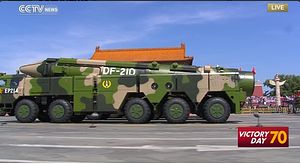China has conducted multiple tests of anti-ship ballistic missiles in the South China Sea, two U.S. officials told NBC News, according to a report published Monday. The tests would mark a significant new type of military activity by the Chinese military in the disputed waters.
According to the report, China has conducted a “series” of such tests. The first test occurred during the weekend and splashed down into unspecified waters in the South China Sea, where Chinese coastal authorities had declared an exclusion zone for live fire military exercises over the last days.
“The window for testing remains open until July 3, and the official expects the Chinese military to test again before it closes,” the report notes.
To date, U.S. officials have not publicized the deployment of any Chinese anti-ship ballistic missiles, like the DF-21D, to the South China Sea. All of these missiles are designed to be road-mobile and could be deployed to China’s islands in the Paracels or its seven artificial islands in the Spratly group.
The United States officially acknowledged starting last year that China has deployed anti-ship cruise missiles and surface-to-air missiles to its outposts in the Spratlys.
It’s unclear if China may have launched a DF-21D anti-ship ballistic missile from the mainland designed to splash down in the South China Sea exclusion zone.
Chinese authorities normally issue expansive Notices to Airmen (NOTAM) for major ballistic missile tests. Between June 30 and July 1, a NOTAM denoting a “temporary danger area” was in place between China’s Hainan Island and a separate maritime exclusion zone off the Spratly Islands.
The NOTAM area and the maritime exclusion zone would have allowed for a ballistic missile test to take place from Hainan or the Chinese mainland.
The deployment of anti-ship ballistic missiles to the Spratly Islands would represent a major shift in China’s posture in the South China Sea. To date, the DF-21D, long described as China’s “carrier-killer” missile, is not known to have been tested end-to-end against a surface-mobile target.
The United States and Japan both have large warships in the South China Sea. The USS Ronald Reagan Carrier Strike Group and the Japan Maritime Self-Defense Force’s Escort Flotilla 1, led by multi-purpose operation destroyer JS Izumo, are in the region.
Anti-ship cruise missiles like the YJ-62 are also known to have been deployed to the South China Sea. These missiles were spotted on Woody Island. Separately, YJ-12B anti-ship cruise missiles were reported to have been deployed to the Spratly Islands in 2018.
The DF-21D is thought to have a range of 1,500 kilometers and is assessed by the U.S. military to provide the Chinese People’s Liberation Army Rocket Force the capability to strike at U.S. forces in the Western Pacific. The missile is known to the U.S. intelligence community also as the CSS-5 Mod 5.
Speaking at the Shangri-La Dialogue, a major Asia security conference, in 2018, then-U.S. Secretary of Defense Jim Mattis addressed China’s new deployments to the Spratlys.
“China’s militarization of artificial features in the South China Sea includes the deployment of anti-ship missiles, surface-to-air missiles, electronic jammers, and more recently, the landing of bomber aircraft at Woody Island,” he noted. Woody Island is in the Paracels.

































